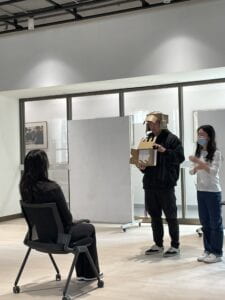4. Performance
Carnival mirror
The first thing to say is, that our live performance was better than any of our rehearsals! We all did our best at the performance. Michelle was in her whole set of costumes; Maggie and I came up with the idea of lipsticks just several minutes before our show; Aidan and Sean worked very well together with matching paces.
Just in case you want to check out performance again (see also on page 1):
Another difference between the actual performance and rehearsals was the stage size and presence of the real audience. On the stage, you had more space to move around and step on; at the same time, by making eye contact with the audience, you got real-time feedback for every sentence and movement in your performance from them. That is how performance becomes interactive, I think.
Another group
All the other groups did an AMAZING job too, among which the one that impressed me the most was the third group. Their performance had three scenes in the fictional context of The Plague. Scene one was about a student volunteer for daily temperature and health checks at the school who asked his professor for an invention to protect him from the virus. The professor gave him a fantastic helmet that blocks all the outside threats to the student. Scene two was simply a girl detected as infected and isolated from others. During the isolation and the deterioration, she was put on a pair of sensory glasses. She completed an “after-life” survey through eye movement and interaction with the monitor – because she was fully stiffened now. And Scene three was when the infected girl actually entered into her imaginary world and was surrounded by the flowers and wearing the butterfly ring she chose.

All the settings fit into the fiction The Plague and also integrate with our daily life. The volunteer for the health check reminded me of the COVID era when everyone was required to wear a mask entering public places and received a temperature check. The silicon virus replaces carbon in the human body, so the infected girl was stiffened but with an active mind. The creativity of this project was most seen from the wish/imagination fulfillment machines, which expressed their good wish and moral care for the infected people. The design of scene three clearly articulates the function and purpose of the artifact. The device was considerably interactive because it had many papers with captions written as the machine’s output to communicate with the user. One minor suggestion as the professors said was that the font of the caption could be bigger so all the audience could see it too (or read it out loud in a robot/AI’s tone).
conclusion & discussion
Overall, this is a good group project. All members contributed actively and collaboratively. We encountered some obstacles and found solutions. We had thoughtful and creative ideas. We were a good team.
In terms of the project, the major realization of interactivity was through performance. The “reflection” mimicking the viewers’ movement and facial expressions, presented the audience with the mirror. Contrasting reactions and monologs dug the more profound significance of the stories, which also aligns with the main idea of the fiction. A possible side-effect of these artifacts could be the overusage of the “Carnival Mirror.” If its owner (the outsider) plans to harm someone psychologically or mentally by manipulating the image of the reflection, that could be a problem. On the other hand, some young people who saw the “miserable kids” in the mirror could turn angry at the real kid locked in the room and take out their anger on the kid, which might harm the kid more badly.
One thought on “Carnival Mirror – Group Research Project”